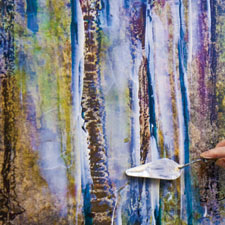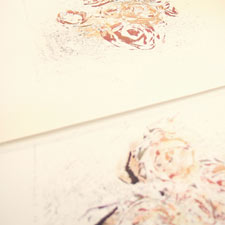Pixels to Paint
Vancouver artist Ellen Scobie creates incredibly detailed digital prints from her photographs.
Ellen’s background in stone lithography printmaking, where she layers textures and colours to beautiful effect, led her to begin working in a similar manner with her digital photographs. The resulting works can be comprised of over 75 layers, each with data pulled from her photos.
After printing her digital imagery onto watercolour paper or canvas, she returns to the tactility of traditional art practices, working into her prints with fine art materials to create stunning mixed media works.
Watch our interview with Ellen, Pixels to Paint and read more about her method of merging photography, her printmaking background, and digital media below in Layer by Layer.
Interested in some of the supplies seen in Pixels to Paint?
Palette Knife
Golden Extra Heavy Gell (Gloss)
Watercolour Paper
Pre-Stretched Canvas
LAYER BY LAYER

Is it a painting, a print, or a photograph?
Vancouver artist Ellen Scobie talks about blurring the lines between the stone age and the digital age.
Experimenting with digital art and artistic mediums offer up new opportunities for creative expression. We met with artist Ellen Scobie to discuss her creative use of digital imagery and fine art materials such as acrylic paints, mediums and glazes. Ellen’s use of traditional and new media allows for considerable versatility and a rich viewer experience as the eye unwraps the many layers that make up her mixed media art.
Opus: Explain your process from taking the photo to printing to completion.
Ellen Scobie: My process starts with lots of photographs. The digital file is just something that I mine for texture or colour. Then I zero in on that photo and isolate something that I like in it, extract it, and use it to start building a new file. With my background as a printmaker, I’m already accustomed to building up my composition layer by layer. So I have taken that process and moved it digitally. Once I have printed it, I can make the choice as to whether I’d like to work on it afterwards or not.
O: Tell us about your background in printmaking and how it compares to how you work with digital media.
ES: Well, my printmaking background started with stone lithography, which has a number of stages. You etch into it to get the image you want then you can ink it up, put your paper onto it, run it through the press, and there you have your first image. Lithography is very time consuming and health-wise there are a lot of hazardous materials. Digitally I can create much faster and there is so much more room for experimentation. Digitally you can move forwards and backwards and you can try out a lot of ideas quickly. You would have to be an extremely accomplished lithographer if you’re working with 8 layers or even less. The pieces I work with now, easily have 75 or more layers, and with lithography that would be technically impossible.
O: How do you decide which images you will work into after they have been printed?
ES: It’s completely intuitive. I have reams and reams of photos, and I just scan them, and see what strikes my fancy. Sometimes the print evolves into a painting that I glaze, and as that happens the composition can shift quite a bit depending on how much I paint into it. Those are works that I’d consider more painterly in nature. The work that I would consider to be more photographic, I typically wouldn’t paint on.
O: Does the feeling you have when you are taking the photographs translate onto your work in the studio?
ES: I’m more like a hunter when I’m out taking photos, because I’m out collecting data. I’m capturing a specific object, a moment, and that’s residing in the digital file that’s captured. Then when I create a new piece, I’m extracting these pixels [from previous photographs] and I like to think of them as sort of digital DNA because they carry with them a source from their origin. In that way it’s like DNA being passed down from one generation to another in the creation of something new. Logically there is something from the original pixel, but, when you’re looking at the piece, you may have no idea where the colour comes from or where I took the image. It’s a completely new embodiment of the digital material.


O: What is it about the process of working into your image with art materials that you enjoy?
ES: Lithography and being in the printmaking studio is about working with your hands and your muscles. You get to grind down the stone, mix your own ink, it’s really a physical process. What I’m doing now is sitting in front of a computer, it’s very clean, it’s digital. I think that’s why I like to go back and paint on some of my prints; it gets me back into the tactility of the piece, working with paint and connecting once again in a manual way. Because the original resides on the computer, it’s like the art is existing in this kind of undefined place. Is it a print? Is it a file? Is it a painting or a photograph? So in some ways it feels important to make it into an object that you can hold.
O: What do you get from working in nature, photographing it, and making art from it?
ES. My work is landscape-based or abstract. Living here on the West Coast, where we are surrounded by so much natural beauty, is a huge influence. I love to go to the beach or into the mountains, and I carry my camera with me, snapping pictures whenever I can. Where I live is basically influencing what I’m doing. Everything is just a reflection of where you are and what you’re experiencing.
O: How is the digital age important to you as an artist?
ES: Without digital technology, I would have no practice at all. Everything that I do is digital. I actually started working by picking up a digital camera and thinking about how I could use it in an artistic way. I didn’t have access to any printmaking studio at that time, so I started thinking like a printmaker would by taking photos and using them in Photoshop with the layering process to create prints. The way technology has progressed in the last few years has made computers, RAM, and memory all cheaper which has really allowed me to expand this process.
O: Do you think merging fine art skills with digital tools is something that artists should try?
ES: If you’re innovative or curious at all, it’s definitely an area to explore. Everyone has a camera now. You know, they say the best camera is the one you have with you, and most of us have a camera in our pocket now with our phones. I, personally, am starting to use my iPhone more and more, and incorporating those photos into my artwork. So it absolutely does not have to stop with just the photo that you are taking. Use it as a stepping-stone into a larger piece or just use it as an explorative device. •
See more of Ellens’s work at www.verosimile.com.


Want to move some of your photographs from the screen to paper or canvas? Ready to display or to use as a base for further experimentation? Opus’s Digital Printing Service is a great place to start with a wonderful selection of fine art digital papers, canvas options, and attention to detail in our printing processes. We also carry a large selection of fine art digital papers for you to use for home printing.
